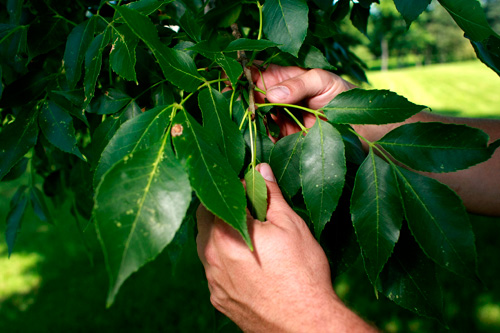On a cold Wednesday morning, one of around 560 ash trees on campus came down. It was a sign of things to come.
The Iowa Department of Natural Resources confirmed this week the discovery of an emerald ash borer larvae in an ash tree on the campus of the University of Iowa, the first discovery of the species in Johnson County. Just one larva is enough to constitute an infestation, because it proves the insects are in the area and breeding.
Andy Dahl, a UI arborist in Building & Landscape Services, said Landscape Services initially discovered the beetle in an ash tree located in Gibson Square.
“We originally found it around two weeks ago, but we had to wait for confirmation from the DNR,” Dahl said. “We knew immediately what it was once we peeled back the bark; we just knew.”
The emerald ash borer is an invasive species originally native to eastern Russia, northern China, Japan, and the Koreas. According to the U.S. Department of Agriculture, the beetle first appeared in Michigan in 2002, and it has killed tens of millions of ash trees across the Midwest and the East since. It threatens to wipe out most of the 8.7 billion ash trees in North America.
Jesse Randall of the Iowa State Forestry extension said the emerald ash borer attacks the vascular system of the tree just under the bark.
“The adult beetle will lay its eggs in the bark, then the larvae will hatch and eat their way in,” he said. “The tree’s unable to move nutrients from its roots, so it dies.”
Dahl said it would not surprise him if an infected tree on the west side of the library parking lot got cut down Wednesday morning after it had been infested by the emerald ash borer.
“It’s not that far from Gibson Square, where the original tree was found,” he said.
UI arborist Mike Rhinehart, who worked on the library lot tree, said there had been a lot of false alarms before the discovery of the beetle.
“They leave very distinct galleries under the bark,” he said. “We won’t know until we cut off the bark from this one to see, but it wouldn’t surprise me.”
In the summer of 2014, an emerald ash borer was discovered in Johnson County, but it was a single beetle, and there was no evidence of breeding.
Though ash trees only make up 7 percent of the tree population on campus, they live in heavily concentrated areas, such as on Washington and Jefferson Streets, where the effect of the emerald ash borer will be most noticeable, Dahl said.
“We’ve known this was coming for a while, so we’ve been diversifying for some time,” he said. “We’re bringing in a lot of different trees, like the Kentucky coffee tree, which is native to Iowa, and the hearty rubber tree is pretty neat as well.”
Dahl said Landscape Services estimates the UI campus will lose around 100 ash trees a year, but they will not be clear cut. Instead, the unhealthiest and hazardous trees will be cut down first.
Iowa City Parks and Recreation Director Juli Seydel-Johnson said the city has come up with a similar plan for the approximately 2,000 ash trees on city property and more on private property.
“It’s a long-term plan, so 10 or 15 years, which is to gradually remove and replace the ash trees with more diverse species of trees so they aren’t as susceptible in the future,” she said.
The majority of ash trees on campus were planted in the 1960s and ’70s in response to the devastation of elm trees caused by Dutch elm disease. Some of the trees being planted to replace the ashes will be disease-resistant elms, which Dahl said gives him hope ash trees will find a way to survive this ever-growing threat.



